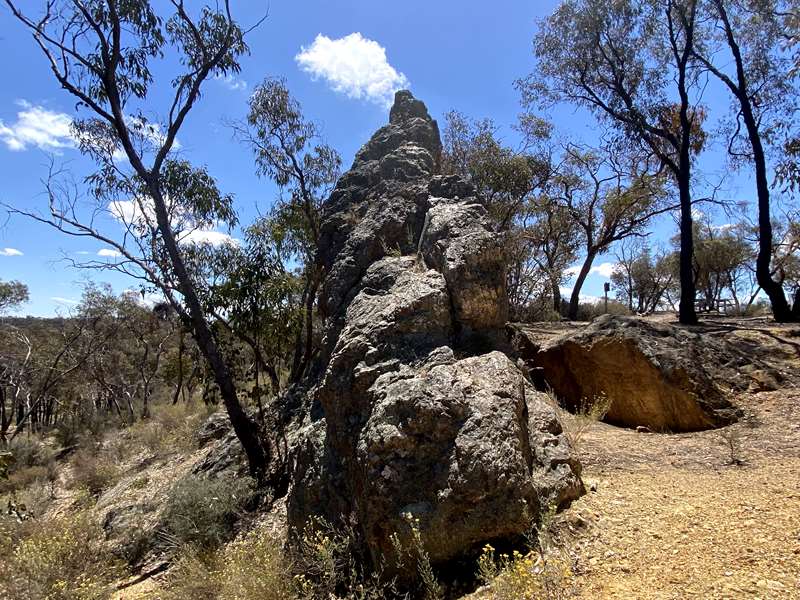St Arnaud - Bell Rock


Bell Rock Reserve can be found by following Butcher St for 1 km north of town on Sebastopol Hill.
At the summit there is a picnic table, signage and a naturally formed rock jutting out of the earth.
During the 1860's to early 1900's there were many mines around Bell Rock, the largest of which was the Lady Nelson. The first claim for silver was staked in 1857. A few years later the Alpha Company started operations but failed due to high operating costs.
Soon after, the Freiburg Company was formed. They built a large dam in the gully below the rock and a 24 head battery to crush the quartz from their mine. This mine failed in 1867, was sold and its name changed to the St Arnaud Gold and Silver Mine, managed by Amos Cheale.
On 12th January 1869, Amos Cheale was shot and killed by Andrew Vair outside the mine. A police search was made for Vair but he was hidden by sympathetic miners. Vair attended Cheale's funeral, sitting up in a tree near the grave. Many of the mourners knew he was there but did not give him away. He lived in a tunnel of an abandoned mine for several months, fed by locals. Some 15 months later, he was arrested near Adelaide, tried and hanged at the Ararat Jail in 1870.
The mine was closed shortly after the murder and the crushing plant converted into the Freiburg Flour Mill. A few years later the flour mill was destroyed by fire. In 1885 the ruins of the mill underwent another metamorphosis and became Eckersly's Eucalyptus Distillery, which became famous all over Australia for its 'Blackfellow' Brand oil.
Bell Rock Vegetation
The St Arnaud Field Naturalists have had an interest in the site for years. In 1995 the group were successful in a bid to preserve the flora of the original 'public purposes reserve' and an additional small area to the east of this area. Importantly, this area would now be exempt from mining. The area around this distinctive rock contains a diverse shrub understory which includes an impressive stand of Boronia anemonifolia (Sticky Boronia) and the threatened species, Stipa breviglumis (Cane Spear Grass).
The area also supports what is known as an ecotone. That is, two distinct populations of eucalypt meet here - the box ironbarks give way to mallee eucalypt.
How to get to Bell Rock
Access to the Bell Rock Reserve is via Butcher Street. From here it is a gravel road and quite rough and rutted although passable by a 2WD car. Along the gravel road there is a sign-posted branch to the left to Bell Rock.
There is a 1 km walking track-signposted, which starts on the east side of the access road and has interpretive signs.
Views
From the turntable the view to the north extends to Mt Jeffcott near Donald and to the east is the American Range and Mt Yawong (with wind generators) and Mts Kooyoora and Moliagul are to the south-east.
The view from Bell Rock picnic area provides a panorama of the cropping country to the north and east of St Arnaud. Spring provides a spectacular sight with a patchwork display of the various crops planted throughout the district. The most vivid is the bright yellow flowers of the Canola crops.
The following information sign is at site:
Rich hopes and crushed dreams
In the 1850s, prospectors flocked to Victoria in search of gold. Sebastopol Hill, as this site was originally known, was rich in minerals like lead, zinc, pyrites, silver and some gold.
Prospectors worked the Armenian, Rotten, Warwickshire and Queen Semiramis reefs, and from 1857, many small mines were established in the area.
Recovering minerals from deep underground, and overcoming the problem of underground water, was a difficult and expensive business. Company mines were formed to raise the necessary capital needed to build shafts up to 130m (400ft) deep. The costs far outstripped the riches extracted. Soon after starting operations here in 1857, the Alpha Co. failed due to high operating costs.
It was re-formed as the Freiburg Co. which built a large dam in the gully below the Rock and a 24-head battery to crush the extracted quartz. However, in 1867, this mine also failed.
It was sold and its name was changed again to the St Arnaud Gold and Silver Mine Co managed by Mr Amos Cheale. Tragically, on 12th January 1869, Cheale was shot and killed outside the mine by Andrew Var, a disaffected local prospector.
The police searched in vain for Vair, who had been well hidden by sympathetic miners. He attended Cheale's funeral, sitting in a tree near the grave. Locals knew he was there but did not give him away.
Vair lived in an abandoned mine tunnel for several months, fed by locals, before fleeing to Adelaide where he was arrested in 1870 and brought back to Victoria. Despite the jury's plea for clemency, Vair became the first man to be hanged at the Ararat Jail.
The mine closed permanently shortly after the murder, and the crushing plant was converted into the Freiburg Flour Mill. A few years later, it too was destroyed by fire. In 1885, the ruins were converted into Eckersley's Eucalyptus Distillery, famous all over Australia for its 'Mentholine' White Mallee (Eucalyptus dumosa) oil.
Photos:
Location
Butcher Street, St Arnaud 3478 View Map









